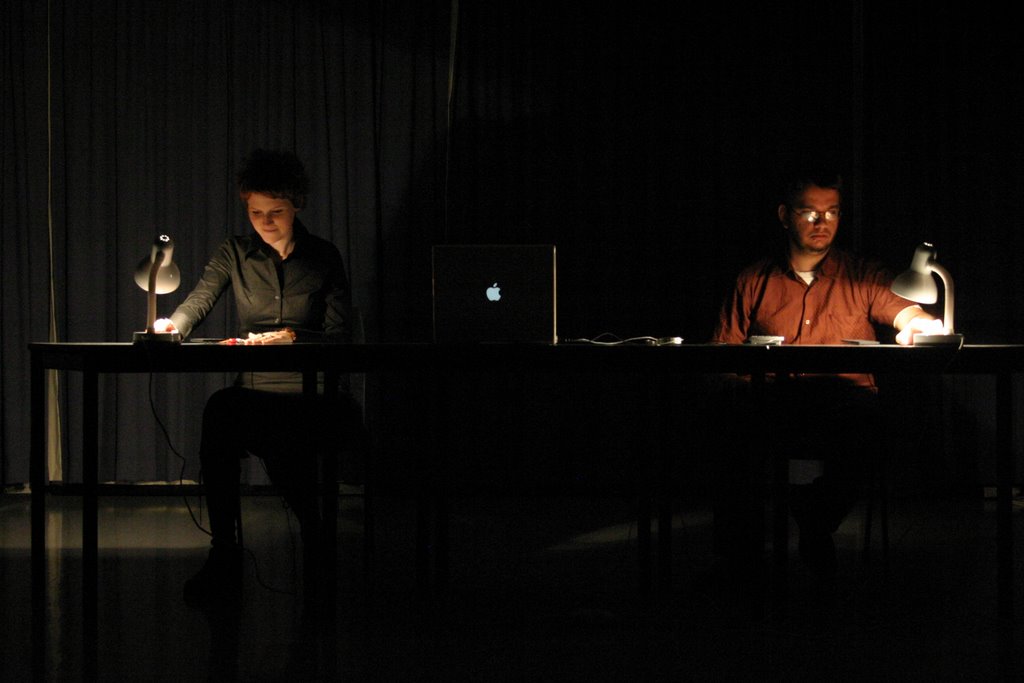Technology Journal week 7 Submission
 #1
#1Forum Speaker: Seb Tomczack
Seb is music technology honors student who has completed the Technology degree. He is also a friend I study with; to see someone I know in an everyday environment doing some creative and imaginative things with music technology was very assuring.

The majority of his musical endeavors are focused around the principle of “taking something out of its usual context and using it for a musical one.*1” One such example of this is his interest in “micro music*2” He has converted a game boy into a music making device. Another was a piece by “Hidden Village” entitled “music for 2 desk lamps” As the title suggest, Seb and the other member of the group Lauren Sutter created music with two desk lamps.
#2 The “Milkcrat
 e Project” was what I found most interesting and inspiring. It was an idea which first began to formulate in his mind in year 11 of high school; to “lock people up in a house with a bunch of rubbish and make them make music.*1” Qualifying this idea was his perception of “music being sounds with constraints placed upon them*1”; so his thoughts were to just further the constraints. “Milkcrate is a music project. The idea is to write music with rules constraining time, space, efficiency and materials.*3”
e Project” was what I found most interesting and inspiring. It was an idea which first began to formulate in his mind in year 11 of high school; to “lock people up in a house with a bunch of rubbish and make them make music.*1” Qualifying this idea was his perception of “music being sounds with constraints placed upon them*1”; so his thoughts were to just further the constraints. “Milkcrate is a music project. The idea is to write music with rules constraining time, space, efficiency and materials.*3”“The rules...
1. The objective of milkcrate is to write, record and produce as much music as possible, creating a completely finished product within twenty- four hours of beginning the session
2. No member of the group is to leave the environment, within reason
3. All materials and raw sources used to create music must be explicitly non- musical
4. All the materials must fit inside or on a milkcrate
5. There is a limit of one milkcrate per person
6. At least one member of the group must be productive at all times
These rules are modular in nature; milkcrate sessions may have additional constraints, so long as they do not break the existing ones.*4”
The various outcomes presented to the forum I found to be very aesthetically pleasing. It was really interesting to listen to the evolution of the project. Despite only hearing less than an hour’s worth of the 7 hour collective, it was quite apparent the increase in sophistication that has occurred in production as the project has matured.
Steel and Glass
Workshop with David Harris.
David played 3 pieces to the class this week with the intention to show vast opposites in music styles
Iannis Xanakis’s “voyage to Andrometer” (1989) was an extremely granular and dynamic piece composed using a UCIF computer which read the graphs which Xanakis designed and converted them to sound.

Gabrielle Manca’s “In Flagrantti” (1990) was a piece for slide guitar with excessive complexity based loosely on the 12 tone system.

Philip Glass’s “Rubric” was a piece for his band that. It was a lot more contemporary then the other two. It seemed more based around the layering of instruments around certain themes and motifs.

I found the Piece by Xanakis most interesting as the other two failed to introduce me to any ideas or concepts that I was not familiar with although they were aesthetically enjoyable
Creative Computing
The new assignment that has been set intrigues me, but I’m worried that having to stay within the frame work of music concrete might limit what I wish to achieve. As I quite enjoy creating music by editing and altering “real world” “non musical” sounds, but if I have to stay within an aesthetical framework I’m not sure if I’ll be able to create to my full potential.
Remixing the Nine Inch Nails song this week was also enjoyable.

NIN Remix
Audio Arts
I have organised a band to record and booked studio time, now I just have to be patient as I’m eager to start this assignment but I am not recording for another 2 weeks.
*1 Seb Tomczack “musical endeavors of seb Tomczack” Lecture presented at University of Adelaide, 27 April 2006.
*2 Wikipedia. “Chiptune” Wikipedia. 29 April 2006. http://en.wikipedia.org/wiki/Chip_music (30 April 2006).
*3 Tomczack, Seb. “welcome to the milkcrate site!” milkcrate project. 24 March 2006. http://www.milkcrate.com.au/home.html (30 April 2006).
*4 Tomczack, Seb. “is what?” milkcrate project. 24 March 2006. http://www.milkcrate.com.au/home.html (30 April 2006).
Picture Refrences (in order of appearance)
#1 1st picture"Tomczack, Seb." 2cnd picture "Hidden Village" little scale blogspot 4 May 2006. http://little-scale.blogspot.com (30 April 2006).
#2 "Milkcrate 1 members" milkcrate project 24 March 2006. www.milkcrate.com.au/session.html (2 March 2006).
#3 "Iannis Xenakis" Classical Music Pages. 10 October 2000. http://w3.rz-berlin.mpg.de/cmp/xenakis.html (30 April 2006).
#4 "InFlagranti-Contemporary Works for guitar" ABC classics 465 701-2. www.johncage.info/cdlabels/abc465701.html (30 April 2006).
#5 "lebrecht music+arts photo library" Philip Glass Pictures. 2004 www.lebrecht.co.uk/lebrecht/glass.htm ( 4 May 2006).
Sound References
#1 "milkcrate session 6 Audio" Milkcrate 24 March 2006. www.milkcrate.com.au/sessions-details-006.html (4 May 2006).

4 Comments:
You spelt technology wrong again. How annoying am I?
Regarding Creative Computing, I agree, it would be nice to create something without having to adhere too strictly to the Music Concrete idiom, but nonetheless I guess our best creative moments can occur when confined to parameters!
Thanks for fixing the spelling, it was keeping me up at night.
More spelling errors found....it's actually "Rubric" by Philip Glass, not Rupert.
Post a Comment
<< Home